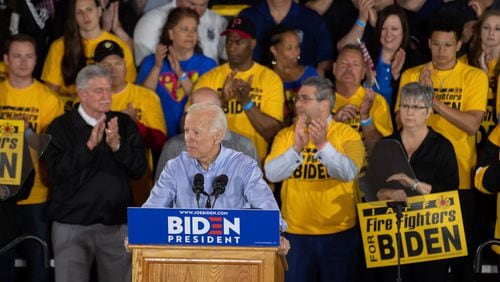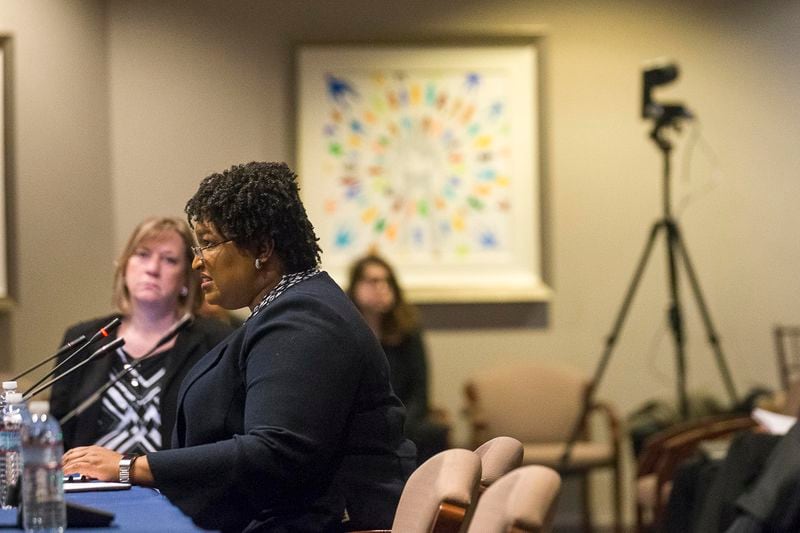On Monday afternoon, Joe Biden walked into the Teamsters Temple, home to Local No. 249 in Pittsburgh, Pa., and launched his third bid for president with a direct appeal to the union workers whom Donald Trump had won over in 2016.
Only a few hours later, at her home in Atlanta, Stacey Abrams picked up her phone and, one by one, began telling a handful of Georgia journalists and Democratic leaders -- state and national -- that she had decided against a U.S. Senate challenge to Republican incumbent David Perdue in 2020.
These were two independent, mostly unrelated actions. But they do have something in common. Both point to the possibility that the Democratic center, nationally and in Georgia, may not be as dead as many people think.
If you ask casual followers of politics what Biden and Abrams have in common, they will point to the trial balloon floated last month, which had the former vice president declaring the former Georgia candidate for governor to be his running mate — right out of the gate. That was a bit of misdirection, obviously.
What Biden and Abrams actually share is strong, deep support from labor unions.
The 2016 presidential campaign showed an obvious gap between national union leaders, who backed Hillary Clinton, and a large percentage of union membership, who didn’t.
Biden’s kitchen-table relationship with blue-collar workers is something close to legendary. Before he gave his Monday union hall speech, Biden was endorsed by the International Association of Fire Fighters – which sat out the 2016 presidential race, refusing to back Clinton.
“Joe’s a lot like our firefighters,” IAFF general president Harold Schaitberger said in the video that accompanied the endorsement. “He knows that a strong middle class means a strong America, and we know, as president, he will stand up for all the patriotic Americans.”
Abrams sealed her relationship with Georgia's union membership while she was state House minority leader. On Feb. 22, 2012, to be exact.
A Republican lawmaker had introduced a bill that would have barred local governments from requiring union participation on major public works projects. “The bond requirements set by federal and state governments are too high for most of these small contractors to meet unless they are part of a union bid,” she argued. Even with unemployment above 9%, Georgia would end up importing workers from out-of-state, she warned.
Credit: Alyssa Pointer
Credit: Alyssa Pointer
Her questioning of the bill’s sponsor was so withering that, though it passed the House, the measure was mortally wounded and disappeared into the bowels of the Senate, never to be seen again. The Atlanta and North Georgia Building Trades Council, the most conservative organization under the Georgia AFL-CIO umbrella, was so delighted with Abrams that it sent DVDs of her state Capitol performance to all its members.
When Abrams began her run for governor in 2017, African-American women would be her primary target in the Democratic primary. But it was solid union support that gave Abrams an instant financial and organizational boost.
Union links have kept both Biden and Abrams tethered. During her run for governor, Abrams became skilled in the use of progressive vocabulary, but her ideas swam in the Democratic middle. Which is very much alive, said Charlie Flemming, president of the Georgia AFL-CIO — an Abrams backer.
“I personally don’t think it’s dead. And I would argue that most of our members don’t think it’s dead,” Flemming said. “The majority, I think, are in the middle.”
A New York Times interview with Abrams was published over the weekend. "I'm a capitalist. I believe in our capital markets," she said. "I believe they need to be heavily regulated. I believe that avarice when left to its own devices is corrosive and that it will always outweigh conscience in our marketplace."
Save for that word “heavily,” the above is a sentiment that could win an endorsement at any union gathering, and in many a church sanctuary. Adam Smith never argued that greed should be given free rein.
There will likely be more, but it is significant that, now that Abrams has left the field, the two most prominent Democratic candidates considering the contest have solid centrist credentials.
Teresa Tomlinson, the former mayor of Columbus, is expected to formally enter the U.S. Senate race on Wednesday. She touts her record in reducing crime, reducing blight and keeping taxes low. She holds national security clearance with the U.S. Department of Defense — something required when you live next to Fort Benning.
Sarah Riggs Amico, the former candidate for lieutenant governor, ran last year as a former Republican who is also an evangelical. And pro-choice, too.
Both Tomlinson and Amico are college-educated white women — in a presidential year where that demographic will be highly courted. But Georgia also has a state Democratic party that is majority African-American. That is something that must be weighed. But back to ideology.
Last Friday, DeKalb County CEO Michael Thurmond, who won three statewide races as state labor commissioner, was on GPB's "Political Rewind" with host Bill Nigut and me. We asked Thurmond, who is African-American, about the coming Democratic presidential primary.
“I think African-American voters are much more sophisticated than people perceive us to be — and moderate, and they’re going to look at the candidates,” Thurmond said. “And like any other Democrat, we want to win.”
So Biden has a chance to win Georgia? I asked.
“Absolutely. I think he will. You have a moderate wing of the party that’s reasserting itself, by the way. We focus on progressives, but what we’re seeing is the moderates coalescing more,” Thurmond said. “I’m talking to moderate Democrats – white, black and other – who are saying we’ve got to be more aggressive, to be more involved. Blacks know Joe Biden.”
It is important to note that DeKalb County represents Georgia’s largest cache of Democratic votes. We asked Thurmond if he himself was interested in making a bid for the U.S. Senate. (He ran and lost against Republican incumbent Johnny Isakson in 2010.)
Thurmond didn’t say no — just that he was awfully busy at the moment.
On Tuesday, I spoke with Tharon Johnson, a Democratic strategist with ties to Thurmond. We were very much of the same mind.
“Stacey Abrams did something very revolutionary in our state. You can’t take that away from her,” Johnson said. Her early and constant outreach to new voters, her targeting of flaws in the state’s election system, her construction of a new biracial coalition — all are things that need to be preserved and grown in the upcoming Senate contest, he said.
“But clearly, the national party is trying to figure out how to get back to the middle. You can’t out-bully Donald Trump, but we do have candidates who can carry the Democratic message in a more moderate tone,” Johnson said.
In essence, 2018 was a year in which Georgia Democrats learned that running to the left has its possibilities. Likewise, 2020 may determine whether it’s the only possibility.









